Henry Jackson Ellicott
Henry Jackson Ellicott (June 22 or 23, 1847 in Annapolis, Maryland – February 11, 1901 in Washington, D.C.) was an American sculptor and architectural sculptor, best known for his work on American Civil War monuments.
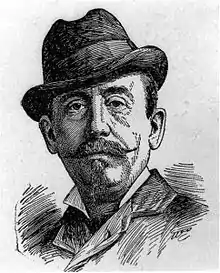
Biography

The son of James P. Ellicott and Fannie Adelaide Ince, he attended Rock Hill College School in Ellicott City, Maryland, and Gonzaga College High School in Washington, D.C. He studied at Georgetown Medical College, and may have served in the Civil War.[1]
At age 19, he completed a larger-than-life plaster statue of Abraham Lincoln – likely an entry in the Lincoln Monument Association's competition for a marble statue – that was exhibited for two years in the United States Capitol rotunda. The competition was won by sculptor Lot Flannery, whose statue is at District of Columbia City Hall. The fate of Ellicott's Lincoln statue is unknown.[2]
He studied at the National Academy of Design, 1867–1870, under William Henry Powell and Emanuel Leutze; and later studied under Constantino Brumidi.[3]
His first two commissions were for monuments at Mount Calvary Cemetery in Lothian, Maryland (1870) and Greenwood Cemetery in Laurel, Maryland. He was the likely modeler of an Infantryman statue for J. W. Fiske Architectural Metals, Inc. of New York City, that was mass-produced and used in numerous municipal Civil War monuments. Company records list the sculptor's name as "Allicot."[4]
He moved to Philadelphia, Pennsylvania, and modeled architectural sculpture on buildings for the 1876 Centennial Exposition.[5] He remained in Philadelphia, and exhibited occasionally at the Pennsylvania Academy of the Fine Arts between 1878 and 1891.[6]
Ellicott was appointed Superintendent and Chief Modeler for the U.S. Treasury Department in 1889, responsible for all federal monuments. He moved to Washington, D.C., where he lived until his death.
Selected works
- Abraham Lincoln, plaster, current whereabout unknown, ca. 1866. Exhibited in United States Capitol rotunda, 1866-1868.
- Goddess of Commerce, Goddess of Protection, Goddess of Mechanism, zinc, atop New England Mutual Life Insurance Building, Boston, Massachusetts, 1875, Nathaniel Jeremiah Bradlee, architect (demolished 1946).[7] The figure group was once the symbol of the company, but the statues were melted down in a World War II scrap-metal drive.[8]
- Recording Angel, atop Thomas P. Duncan Mausoleum, Union Dale Cemetery, Pittsburgh, Pennsylvania, 1880, Theophilus Parsons Chandler, Jr., architect.
- Bas-relief portrait of John Sartain, bronze, Pennsylvania Academy of the Fine Arts, Philadelphia, Pennsylvania, ca. 1888.
- Architectural sculpture: 33 Keystones (Ethnological Heads), granite, Library of Congress, Washington, D.C., 1891. Carved by Ellicott and William Boyd.
- Bust of George M. Dallas, marble, United States Senate Vice Presidential Bust Collection, United States Capitol, Washington, D.C., 1893.[9]
- Francis Elias Spinner, bronze, Myers Park, Herkimer, New York, 1894.[10]
- Zebulon Baird Vance Monument, bronze, North Carolina State Capitol, Raleigh, North Carolina, 1899-1900.
- Bust of Rear-Admiral George W. Melville, bronze, United States Naval Academy Museum, Annapolis, Maryland.
Civil War monuments
- Goddess of Victory, bronze, atop Soldiers' Monument, Veterans Park, Holyoke, Massachusetts, 1875-76.[11]
- Colonel James Cameron, granite with brass sword, Civil War Monument, Cameron Park, Sunbury, Pennsylvania, 1879.[12]
- Infantryman, bronze, Civil War Monument, Lawrence, Massachusetts, 1881. The Sailor and Cavalry Officer figures were modeled by William Rudolf O'Donovan.
- Cavalryman, bronze, 2nd Pennsylvania Cavalry Monument, Gettysburg Battlefield, Gettysburg, Pennsylvania, 1887-1889.
- Kneeling Cavalryman, bronze, 1st Pennsylvania Cavalry Monument, Gettysburg Battlefield, Gettysburg, Pennsylvania, 1889-90.
- Equestrian statue of General Winfield Scott Hancock, bronze, Washington, D.C., 1889-1896.
- Equestrian statue of General George B. McClellan, bronze, City Hall, Philadelphia, Pennsylvania, 1891-1894.
Attributed works
- Infantryman, zinc, modeled by "Allicot" (Ellicott?) and mass-produced by J. W. Fiske Architectural Metals, Inc., New York City, from ca. 1875 to 1927. Examples in Saratoga, New York (1875), Chambersburg, Pennsylvania (1878), King Ferry, New York (1882), Arcadia, Missouri (1886), Norwalk, Connecticut (1889), Oak Bluffs, Massachusetts (1890), Martha's Vineyard, Massachusetts (1891),[13] Pottstown, Pennsylvania (1893), Berlin, New York (1906), Iola, Kansas (1909), and North Kingston, Rhode Island (1912).
- Charles Evans, bronze, Charles Evans Cemetery, Reading, Pennsylvania.[14] The undated statue is signed "ELLICOTT SC." and was cast by Bureau Brothers Foundry in Philadelphia.[15]
 New England Mutual Life Insurance Building, (1875), Boston, Massachusetts. Razed and statues destroyed, 1945.
New England Mutual Life Insurance Building, (1875), Boston, Massachusetts. Razed and statues destroyed, 1945. Soldiers Monument (1875–76), Holyoke, Massachusetts.
Soldiers Monument (1875–76), Holyoke, Massachusetts. Thomas P. Duncan Mausoleum (1880), Pittsburgh, Pennsylvania.
Thomas P. Duncan Mausoleum (1880), Pittsburgh, Pennsylvania. Infantryman (1881), Civil War Monument, Lawrence, Massachusetts.
Infantryman (1881), Civil War Monument, Lawrence, Massachusetts.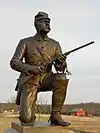 1st Pennsylvania Cavalry Monument (1889–90), Gettysburg Battlefield, Gettysburg, Pennsylvania.
1st Pennsylvania Cavalry Monument (1889–90), Gettysburg Battlefield, Gettysburg, Pennsylvania.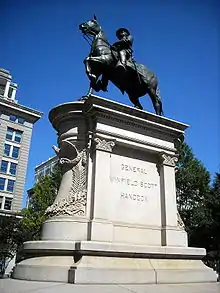 General Winfield Scott Hancock Memorial (1889–1896), Washington, D.C.
General Winfield Scott Hancock Memorial (1889–1896), Washington, D.C._(292984768).jpg.webp) Lakota Keystone (1891), Library of Congress, Washington, D.C. One of 33 keystone heads.
Lakota Keystone (1891), Library of Congress, Washington, D.C. One of 33 keystone heads.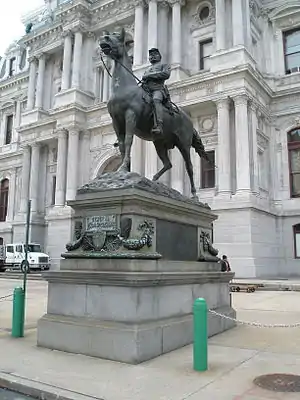 General George McClellan (1891–1894), City Hall, Philadelphia, Pennsylvania.
General George McClellan (1891–1894), City Hall, Philadelphia, Pennsylvania.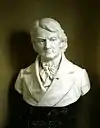 Bust of George M. Dallas (1893), United States Senate Vice Presidential Bust Collection, United States Capitol, Washington, D.C.
Bust of George M. Dallas (1893), United States Senate Vice Presidential Bust Collection, United States Capitol, Washington, D.C. Vance Monument (1899-1900), North Carolina State Capitol, Raleigh.
Vance Monument (1899-1900), North Carolina State Capitol, Raleigh.
References
- An 1896 New York Times article implies that the 16-year-old Ellicott was present at the July 1863 Battle of Gettysburg.
- Louis A. Warren, "The Curious Story of Ellicott's Lincoln," Lincoln Herald, vol. 48-49, 1946.
- Charles Edwin Fairman, Works of Art in the United States Capitol Building: Including Biographies of the Artists (Washington, D.C.: Government Printing Office, 1913), p. 22.
- Fiske Infantryman from JAIC online.
- "Henry Jackson Ellicott," Twentieth Century Biographical Dictionary of Notable Americans, Rossiter Johnson, ed. (1904).
- Susan James-Gadzinski and Mary Mullen-Cunningham, "Henry J. Ellicott," American Sculpture in the Pennsylvania Academy of the Fine Arts (Seattle: University of Washington Press, 1997), pp. 106-07.
- Closeup of the building from Boston Public Library via Flickr.
- Company Timeline from New England Mutual Life Insurance Company.
- George M. Dallas bust from U.S. Senate.
- General Spinner
- Holyoke Soldiers' Monument from Library of Congress.
- Colonel Cameron
- Martha's Vineyard Infantryman from The Washington Times.
- Charles Evans from USGW Archives.
- Charles Evans from SIRIS.
External links
![]() Media related to Henry Jackson Ellicott at Wikimedia Commons
Media related to Henry Jackson Ellicott at Wikimedia Commons